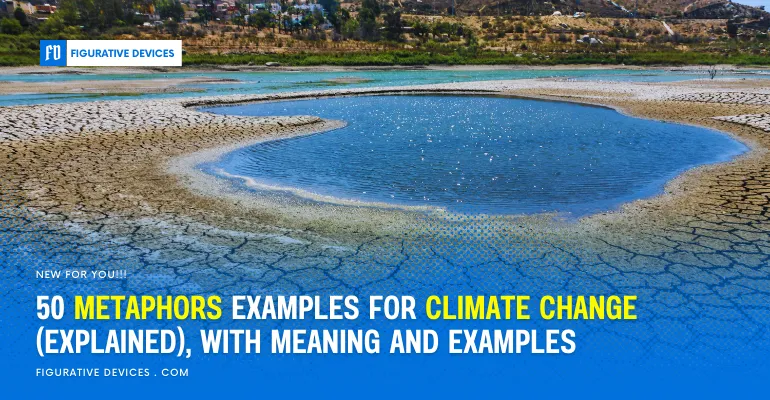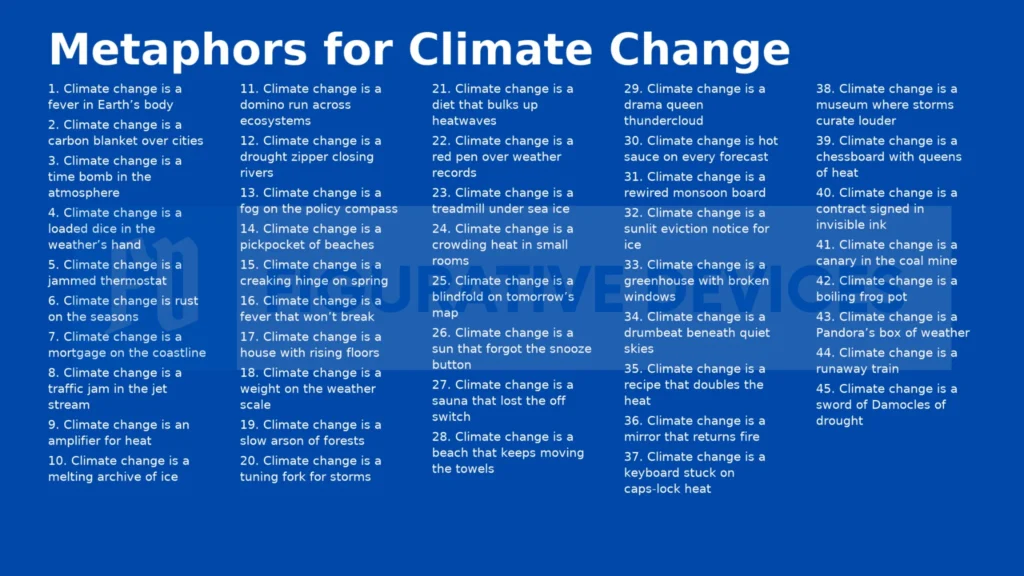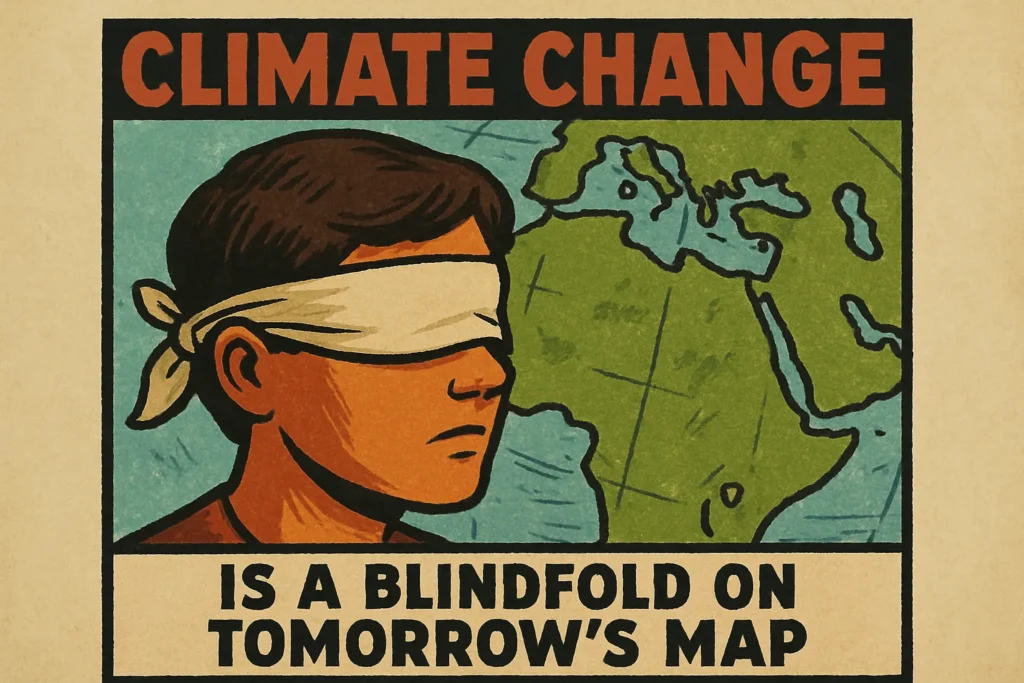Climate Change Metaphors: 50 Weather Shift Comparisons

Climate Change Metaphors: 50 Weather Shift Comparisons
Metaphors sharpen climate change into imaginative images like complex shifts—heat, ice loss, storms—into concrete frames that you can quote in talks, articles, and everyday chats; this metaphors collection gives a complete set: and final weather connection.
Metaphors for Climate Change (15)
Climate change is a fever in Earth’s body
Meaning & When to Use: Use for rising global temperatures and health analogies in schools, reports, or posts.
Example: “I see climate change as a fever in Earth’s body that keeps spiking.”
Other Ways to Say: heat surge, thermal flare, planetary temperature spike, systemic heat signal, warming symptom leading to later standouts.
Climate change is a carbon blanket over cities
Meaning & When to Use: Use for greenhouse gases trapping heat over urban areas.
Example: “By midnight, the carbon blanket still smothered the streets.”
Other Ways to Say: heat dome, smog quilt, sky insulation, atmospheric cover, retained warmth toward exemplars.
Climate change is a time bomb in the atmosphere
Meaning & When to Use: Use for delayed impacts like sea-level rise and permafrost thaw.
Example: “That quiet glacier hides a time bomb in the atmosphere.”
Other Ways to Say: ticking risk, latent hazard, stored shock, deferred blast, pending trigger near standouts.

Climate change is a loaded dice in the weather’s hand
Meaning & When to Use: Use for shifted probabilities of extremes.
Example: “I tell students the storms roll with loaded dice now.”
Other Ways to Say: skewed odds, biased roll, tilted chance, rigged probabilities, weight toward exemplars.
Climate change is a jammed thermostat
Meaning & When to Use: Use when control systems fail to cool the planet.
Example: “Summer felt like a jammed thermostat stuck on high.”
Other Ways to Say: stuck dial, frozen setting, locked control, seized switch, fixed heat pointing to standouts.
Climate change is rust on the seasons
Meaning & When to Use: Use for disrupted seasonal timing.
Example: “Bloom times wear rust on the seasons now.”
Other Ways to Say: tarnished calendar, corroded spring, oxidized autumn, weathered cycle, aging pattern near exemplars.
Climate change is a mortgage on the coastline
Meaning & When to Use: Use for sea-level rise and recurring flood costs.
Example: “Each storm calls in the mortgage on the coastline.”
Other Ways to Say: rising interest, coastal debt, flood premium, ocean lien, shoreline dues toward standouts.
Climate change is a traffic jam in the jet stream
Meaning & When to Use: Use for stuck weather patterns.
Example: “The heatwave idled in a jet-stream traffic jam.”
Other Ways to Say: stalled current, blocked lane, wavering track, loopy flow, slow ridge guiding exemplars.
Climate change is an amplifier for heat
Meaning & When to Use: Use for extremes made stronger.
Example: “That record wasn’t born alone; an amplifier for heat pushed it.”
Other Ways to Say: booster, loudener, gain knob, power stage, signal lift moving to standouts.
Climate change is a melting archive of ice
Meaning & When to Use: Use for glaciers storing climate records.
Example: “I read a melting archive of ice and lost pages ran to sea.”
Other Ways to Say: thawing library, dripping ledger, vanishing record, dissolving scroll, fading chronicle toward exemplars.
Climate change is a domino run across ecosystems
Meaning & When to Use: Use for cascading impacts.
Example: “A reef falls, and the domino run crosses the bay.”
Other Ways to Say: chain reaction, cascade line, spillover path, ripple corridor, effect ladder into standouts.
Climate change is a drought zipper closing rivers
Meaning & When to Use: Use for prolonged dry spells.
Example: “By August the drought zipper closed our stream.”
Other Ways to Say: parched seal, water clamp, rain lock, sky seal, moisture lid near exemplars.
Climate change is a fog on the policy compass
Meaning & When to Use: Use when uncertainty clouds decisions.
Example: “Budget talks moved under a fog on the policy compass.”
Other Ways to Say: hazy bearing, blurred needle, dim heading, clouded chart, muted azimuth guiding standouts.
Climate change is a pickpocket of beaches
Meaning & When to Use: Use for erosion and loss of sand.
Example: “Each king tide is a pickpocket of beaches.”
Other Ways to Say: sand thief, dune robber, shoreline lifter, coast skimmer, littoral loss toward exemplars.
Climate change is a creaking hinge on spring
Meaning & When to Use: Use for early thaws and mismatched blooms.
Example: “Birdsong arrived on a creaking hinge on spring.”
Other Ways to Say: squeaky gate, off-kilter latch, loose pin, misfit door, seasonal swing toward standouts.
10 Best Metaphors for Climate Change
Climate change is a fever that won’t break
Meaning & When to Use: Use in headlines and openings for urgency.
Example: “Our region runs a fever that won’t break.”
Other Ways to Say: unbroken heat, persistent burn, relentless warmth, constant blaze, top-tier standout lines leaning to humor.
Climate change is a house with rising floors
Meaning & When to Use: Use for sea-level rise reframed as baselines shifting up.
Example: “Flood maps live in a house with rising floors.”
Other Ways to Say: lifting ground, climbing baseline, elevating base, upward drift, standout image toward lightness.
Climate change is a weight on the weather scale
Meaning & When to Use: Use for probability shifts of extremes.
Example: “Heat records tip under a weight on the weather scale.”
Other Ways to Say: heavier side, loaded pan, tipped balance, massed chance, standout pivot toward humor.
Climate change is a slow arson of forests
Meaning & When to Use: Use for wildfire seasons amplifying.
Example: “I smelled the slow arson of forests by July.”
Other Ways to Say: creeping burn, steady scorch, drawn-out ember, prolonged blaze, standout tension before humor.
Climate change is a tuning fork for storms
Meaning & When to Use: Use for storms intensifying with warmer seas.
Example: “Warm water rang a tuning fork for storms.”
Other Ways to Say: resonance driver, storm key, cyclone pitch, hurricane tone, standout resonance into humor.
Climate change is a diet that bulks up heatwaves
Meaning & When to Use: Use for hotter, longer heatwaves.
Example: “The city eats a diet that bulks up heatwaves.”
Other Ways to Say: caloric sky, thermal calories, energy intake, heat protein, standout phrasing toward levity.
Climate change is a red pen over weather records
Meaning & When to Use: Use when records keep falling.
Example: “June wore a red pen over weather records.”
Other Ways to Say: marked chart, scored ledger, edited climate, corrected baseline, standout record cue to humor.
Climate change is a treadmill under sea ice
Meaning & When to Use: Use for constant motion and loss.
Example: “Seals hunt on a treadmill under sea ice now.”
Other Ways to Say: moving floor, sliding base, drifting platform, restless sheet, standout motion toward humor.
Climate change is a crowding heat in small rooms
Meaning & When to Use: Use for urban heat islands and equity talks.
Example: “Apartments hold a crowding heat in small rooms.”
Other Ways to Say: packed warmth, tight air, dense hotness, pressed climate, standout equity line into humor.
Climate change is a blindfold on tomorrow’s map
Meaning & When to Use: Use for planning uncertainty.
Example: “We zone with a blindfold on tomorrow’s map.”
Other Ways to Say: masked route, hidden path, unclear chart, veiled grid, standout segue to playful takes.

5 funny Metaphors for Climate Change
Climate change is a sun that forgot the snooze button
Meaning & When to Use: Use to lighten a hot-day post.
Example: “By noon the sun forgot the snooze button again.”
Other Ways to Say: overcaffeinated dawn, eager daylight, early riser sky, jumpy sunshine, playful bridge to fresh angles.
Climate change is a sauna that lost the off switch
Meaning & When to Use: Use for sticky heat humor.
Example: “My street turned into a sauna with no off switch.”
Other Ways to Say: endless steam room, permanent spa, nonstop sweat box, eternal mist, light path to new frames.
Climate change is a beach that keeps moving the towels
Meaning & When to Use: Use for erosion and shifting shorelines.
Example: “The beach moved our towels three blocks inland.”
Other Ways to Say: fussy coastline, restless sandbar, migrating dune, nomad shore, playful cue to new imagery.
Climate change is a drama queen thundercloud
Meaning & When to Use: Use when storms overperform.
Example: “That drama queen thundercloud stole the show.”
Other Ways to Say: extra storm, showy squall, flashy cell, theatrical downpour, humor that opens fresh lines.
Climate change is hot sauce on every forecast
Meaning & When to Use: Use for repeated heat advisories.
Example: “This week tastes like hot sauce on every forecast.”
Other Ways to Say: spicy outlook, peppered week, zesty sky, chili noon, playful step to new metaphors.
10 New Metaphors for Climate Change
Climate change is a rewired monsoon board
Meaning & When to Use: Use for altered rainfall timing.
Example: “Farmers face a rewired monsoon board.”
Other Ways to Say: updated rain circuit, shifted storm grid, patched sky panel, altered wet map, fresh frame toward heritage.
Climate change is a sunlit eviction notice for ice
Meaning & When to Use: Use for glacier retreat.
Example: “The valley holds a sunlit eviction notice for ice.”
Other Ways to Say: bright decree, warm writ, glowing order, radiant summons, new phrasing toward roots.
Climate change is a greenhouse with broken windows
Meaning & When to Use: Use when delicate balance fails.
Example: “Our climate feels like a greenhouse with broken windows.”
Other Ways to Say: cracked panes, leaky frame, warped glass, skewed shelter, novel angle toward heritage.
Climate change is a drumbeat beneath quiet skies
Meaning & When to Use: Use for subtle long-term trends.
Example: “Even calm days carry a drumbeat beneath quiet skies.”
Other Ways to Say: soft tempo, hidden rhythm, low pulse, steady thrum, new cadence to roots.
Climate change is a recipe that doubles the heat
Meaning & When to Use: Use for compounding factors.
Example: “That storm followed a recipe that doubles the heat.”
Other Ways to Say: extra spice, added energy, boosted mix, enriched brew, fresh kitchen to heritage pantry.
Climate change is a mirror that returns fire
Meaning & When to Use: Use when landscapes reflect heat back.
Example: “The city’s mirror returns fire at dusk.”
Other Ways to Say: radiant echo, heat bounce, thermal reply, burning glance, new spark to old sayings.
Climate change is a keyboard stuck on caps-lock heat
Meaning & When to Use: Use in social posts about hyperbolic temperatures.
Example: “Today typed in caps-lock heat.”
Other Ways to Say: loud text, shouting temp, uppercase sun, bold air, modern tone toward heritage.
Climate change is a museum where storms curate louder
Meaning & When to Use: Use for intensifying extremes over time.
Example: “Each exhibit storms in louder than the last.”
Other Ways to Say: louder gallery, stronger curation, bolder halls, fiercer display, new exhibit to old archive.
Climate change is a chessboard with queens of heat
Meaning & When to Use: Use for powerful, mobile threats.
Example: “The endgame shows queens of heat across the board.”
Other Ways to Say: dominant piece, roaming threat, strategic heat, mobile danger, fresh tactic to roots.
Climate change is a contract signed in invisible ink
Meaning & When to Use: Use for commitments that only reveal later.
Example: “We discover the terms as the seas rise.”
Other Ways to Say: hidden clause, fading text, latent promise, delayed reveal, new script to old lines.
5 Old Metaphors for Climate Change
Climate change is a canary in the coal mine
Meaning & When to Use: Use as a classic early-warning image.
Example: “The reef acts like a canary in the coal mine.”
Other Ways to Say: early signal, sentinel species, warning bell, first alarm, heritage cue toward pairing.
Climate change is a boiling frog pot
Meaning & When to Use: Use for slow, unnoticed danger.
Example: “Policy sat in a boiling frog pot for years.”
Other Ways to Say: creeping peril, slow cook, gradual trap, simmering risk, heritage bridge to pairing.
Climate change is a Pandora’s box of weather
Meaning & When to Use: Use for unleashed surprises.
Example: “Open emissions and a Pandora’s box of weather flies out.”
Other Ways to Say: jar of troubles, chest of gusts, trove of shocks, basket of squalls, old myth to pair-work.
Climate change is a runaway train
Meaning & When to Use: Use for feedbacks and momentum.
Example: “Glaciers slide under a runaway train of heat.”
Other Ways to Say: unchecked engine, speeding car, loose brake, wild carriage, heritage speed into pair section.
Climate change is a sword of Damocles of drought
Meaning & When to Use: Use for looming scarcity.
Example: “The valley farms live under a sword of drought.”
Other Ways to Say: hanging threat, overhead risk, poised blade, suspended fear, old motif to pairing next.
5 Metaphors for Climate Change & Metaphors for Weather
Climate change is a stage manager; weather is the daily performance
Meaning & When to Use: Use to clarify climate vs. weather roles.
Example: “I tell classes: climate change sets the stage, weather performs.”
Other Ways to Say: backstage climate, front-stage weather, script and show, director and actor, linked frame for both topics.
Climate change is the deck tilt; weather is each card
Meaning & When to Use: Use for probability shifts across events.
Example: “With the deck tilt, every weather card plays higher.”
Other Ways to Say: biased table, single draw, long odds, daily hand, paired lens for internal linking.
Climate change is the canvas; weather is the brushstroke
Meaning & When to Use: Use for big-picture background vs. day-to-day variation.
Example: “Storms paint wild brushstrokes on a warming canvas.”
Other Ways to Say: ground layer and marks, base coat and strokes, mural and dabs, wall and paint, bridge phrase across pages.
Climate change is the ocean current; weather is the wave
Meaning & When to Use: Use to show scale and persistence.
Example: “A fierce wave rides a shifting current beneath.”
Other Ways to Say: flow and crest, trend and spike, drift and splash, stream and ripple, tie binding climate and weather.
Climate change is the recipe; weather is the meal
Meaning & When to Use: Use when ingredients set outcomes but dishes still vary.
Example: “Hotter seas rewrite the recipe; this week’s meal tastes stormy.”


